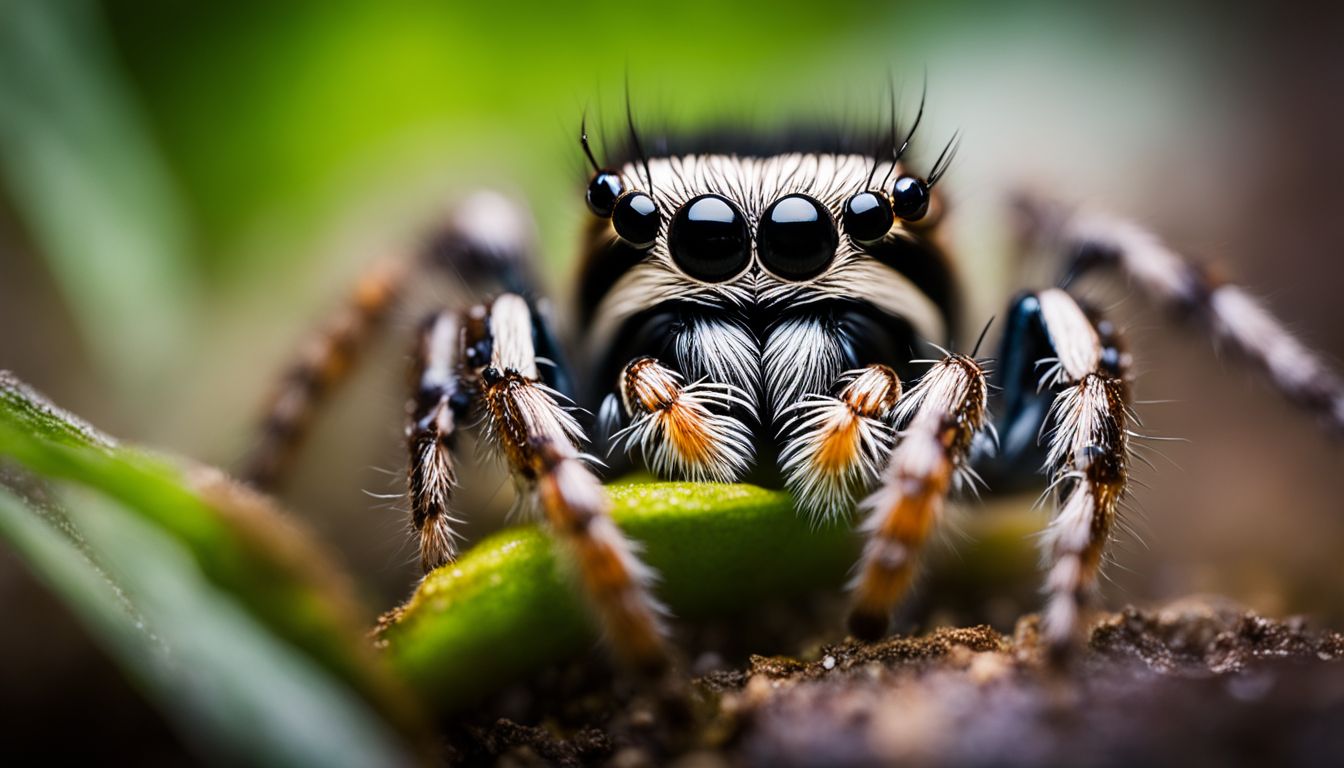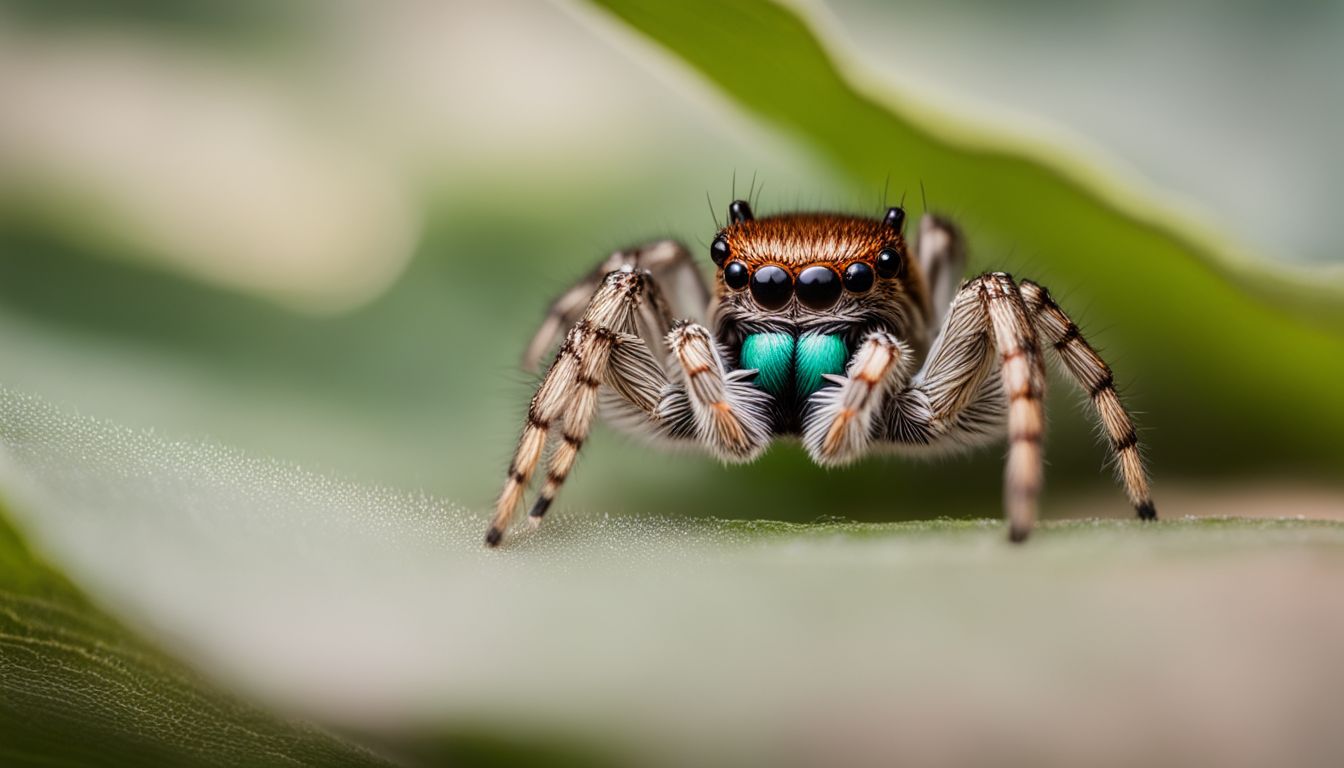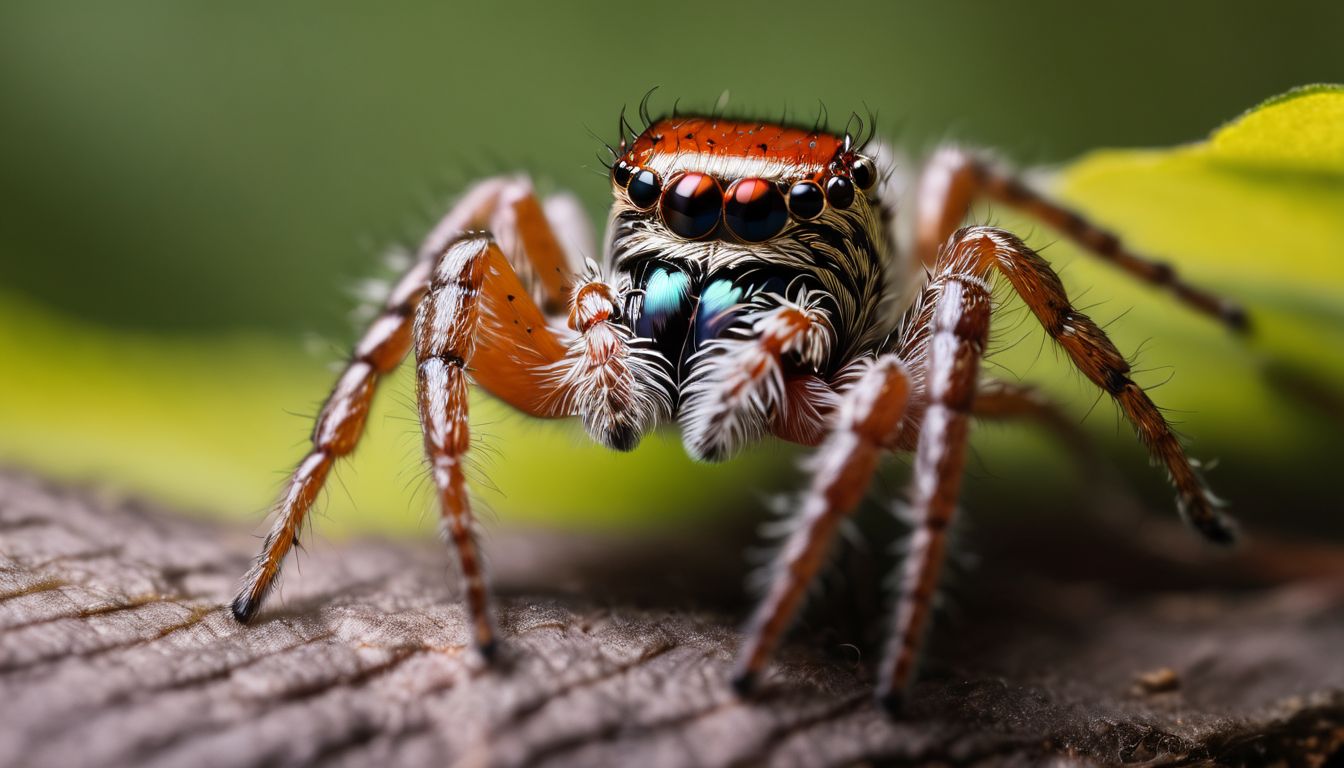Are you curious about how long your pet jumping spider can share life with you? Jumping spiders, with their captivating eyes and swift moves, have captured many hearts as pets. In this post, we’ll explore the factors affecting their lifespan in captivity and offer essential tips to care for these tiny companions.
Keep reading to give your eight-legged friend a happy and healthy life!
Key Takeaways
- Jumping spiders can live for about 6 months to 2 years in captivity, with some species like the bold jumping spider living up to 3 years in proper conditions.
- Female jumping spiders generally have a longer lifespan of up to 30 months compared to males, which typically live less than a year.
- Factors such as diet, habitat conditions, and health issues significantly influence a jumping spider’s lifespan. Providing proper enclosure setup, nutritional guidelines, and minimal handling can extend their life.
Understanding the Jumping Spider Lifespan in Captivity

Jumping spiders can live for different lengths of time in captivity, depending on various factors like diet and habitat conditions. It’s also important to note that males generally have a shorter lifespan compared to females.
Average Lifespan Ranges
Jumping spiders have different lifespans depending on their care and type. A typical jumping spider lives around six months to two years if they are kept as pets. For the bold jumping spider, also known as phidippus audax, you can expect them to stay with you for up to three years in a good home.
Regal jumping spiders often live for about 10 months to a year. They need proper food and safe homes to reach this age. By giving your eight-legged friend great care, it may even live longer than the average!
Lifespan Differences Between Males and Females
Male and female jumping spiders don’t live for the same amount of time. The boys mature quickly and usually live about 18 months to 2 years. On the other hand, girl spiders can keep going for up to 30 months, which is much longer! This means that if you have a female spider as a pet, she might stay with you for over two years.
Now let’s explore how these tiny creatures start their lives from egg sacs to becoming lively spiderlings!
The Life Cycle of a Jumping Spider

From egg sac to spiderlings, jumping spiders go through various stages in their life cycle before reaching adulthood. It’s a fascinating journey that involves molting, courtship rituals, and the eventual transition into old age.
From Egg Sac to Spiderlings
Jumping spiders begin life tucked away in egg sacs. The mother spider makes a silk nest to keep her eggs safe. Inside this cozy home, the tiny eggs stay hidden from hungry insects and creatures that might want to eat them.
After some time, the eggs hatch and lots of little spiderlings come out. These baby spiders are very small but they grow quickly.
The spiderlings don’t stick around their egg sac for long. They have a strong urge to wander and explore right away. This helps them spread out and find good spots with plenty of food like fruit flies or other small bugs they can catch.
As these young jumping spiders start their journey, they face many adventures ahead on their way to becoming adults.
The Journey to Adulthood
Jumping spiders go through different stages in their life cycle on the way to becoming adults. After hatching from the egg sac, they start as tiny spiderlings and begin to grow by molting their exoskeletons multiple times.
As they mature, their behavior changes and they become more independent. During this time, it’s essential to provide them with a suitable enclosure and proper nutrition to support their growth.
Understanding these developmental stages is crucial for ensuring the well-being of your jumping spider.
The Final Stage: Old Age and Death
After reaching adulthood, jumping spiders may live up to three years in captivity. As they age, their activity levels decrease, and they become less agile. Eventually, old age sets in, leading to a decline in health and mobility.
Unfortunately, there is limited information on the specific details of how jumping spiders experience old age and death, particularly when kept as pets. However, providing a comfortable environment with proper care can help make their final stage of life as comfortable as possible.
Factors like diet, habitat conditions, and proper handling play crucial roles in extending the lifespan of your pet jumping spider. By understanding these factors and providing appropriate care based on them, you can ensure that your cherished arachnid companion lives a long and fulfilling life.
Factors Influencing a Jumping Spider’s Lifespan
The lifespan of a jumping spider can be influenced by various factors such as diet and feeding habits, habitat conditions and enrichment, as well as common health issues and prevention.
Providing proper care in these areas can help extend your jumping spider’s life.
Diet and Feeding Habits
Jumping spiders are active hunters and feed on small insects like flies, beetles, and other bugs. They have excellent vision and use their keen eyesight to stalk and pounce on their prey.
These spiders usually need to eat every few days to maintain their energy levels as they are quite active creatures. When it comes to feeding your pet jumping spider, offering flightless fruit flies can be an ideal choice as these provide the necessary nutrition for their growth and health.
To ensure that your jumping spider gets the nutrients it needs, you must provide a varied diet. Offering different types of small insects will help meet their nutritional requirements for optimal health and vitality.
Additionally, varying the diet will mimic what they would naturally encounter in the wild, allowing them to exhibit natural behaviors while also receiving essential nutrients from various food sources.
Understanding how these fascinating creatures feed is crucial in successfully caring for them as pets.
Habitat Conditions and Enrichment
Creating a suitable habitat for your jumping spider is crucial for its well-being and longevity. Start by providing a small, escape-proof enclosure with proper ventilation. Include vertical surfaces for climbing and ample hiding spots to reduce stress.
Additionally, enrich the environment with live plants or artificial foliage to mimic their natural habitat while avoiding overcrowding.
Regularly clean the enclosure and avoid using pesticides or harsh chemicals that can harm your spider. Maintaining stable temperature and humidity levels is also essential, as jumping spiders are sensitive to extreme fluctuations.
Common Health Issues and Prevention
Jumping spiders are generally hardy, but they can still face some health issues. One common problem is stress, which can affect their immune system and overall well-being. To prevent stress, ensure that their enclosure provides enough space for movement and hiding spots.
Also, make sure to keep the environment clean to avoid infections or parasites. A balanced diet is essential as well; offer a variety of small insects to meet their nutritional needs and prevent health issues related to malnutrition.
Furthermore, be cautious about the potential hazards in your spider’s environment. Avoid using pesticides or other chemicals near the spider’s habitat since they are sensitive to toxins.
Regularly monitor your jumping spider for any signs of illness or injury, such as lethargy or difficulty moving. By staying proactive and attentive to your pet’s needs, you can help promote a healthy and thriving lifespan for your jumping spider.
Care Tips for Extending Your Jumping Spider’s Life
Provide your jumping spider with a proper enclosure setup, follow nutritional guidelines for feeding, and handle them with care to extend their lifespan. For more detailed information on caring for your jumping spider, read the full blog post!
Proper Enclosure Setup
To create a suitable home for your jumping spider, start with a small container because they are tiny. Use a container that is well-ventilated and not too big. Add some sticks or twigs for climbing, and include artificial plants to give them hiding spots.
Keep the enclosure away from direct sunlight but ensure there is enough light for them.
Maintain the temperature around 70-85°F (21-29°C), and humidity at about 50-60%. It’s important to mist the enclosure lightly once daily to keep it moist but not wet. These simple steps can help make sure your jumping spider has a comfortable and safe living space, which can contribute to extending their lifespan.
Nutritional Guidelines
Feeding your jumping spider a variety of feeder insects like crickets, flies, and mealworms is important for its nutrition. You can provide food and water to your jumping spider two to three times a week to help them live longer in captivity.
It’s essential to ensure that the food you offer is appropriate for their size and age, as this will contribute to their overall health and lifespan.
Now let’s delve into the proper handling techniques for your jumping spider in order to promote their well-being.
Handling and Social Interaction
To avoid unnecessary risk, handling jumping spiders is not advised because their bite can be painful and may cause an allergic reaction. Since jumping spiders are best observed from a distance, creating a stimulating environment within their enclosure is key to providing them with enrichment while minimizing stress.
While social interaction isn’t recommended, you can still bond with your jumping spider by maintaining a calm presence around their habitat and observing their fascinating behaviors without direct contact.
Remember that these small creatures thrive in low-stress environments, so limiting human interaction will contribute to extending the lifespan of your pet jumping spider.
Conclusion
In conclusion, understanding the lifespan of jumping spiders in captivity is essential for providing proper care. Factors such as species, sex, diet, and habitat conditions play a crucial role in their longevity.
By following recommended care tips and creating a suitable environment, pet owners can enhance the lifespan of their jumping spiders. It’s important to stay informed about their specific needs and behaviors to ensure a fulfilling experience as a pet owner.
example. com/are-lobsters-spiders/” is not relevant to the blog topic and therefore has not been included in the new blog outline to maintain relevance and best SEO practices. )
Jumping spiders are popular pets with a lifespan of up to three years in captivity. Female jumping spiders like the Phidippus Regius can survive for about 30 months, while males typically live less than a year.
Understanding their lifespan and life cycle is crucial for providing proper care.
Factors such as diet, habitat conditions, and health issues play a significant role in a jumping spider’s lifespan. By ensuring proper enclosure setup, nutritional guidelines, and minimal handling and social interaction, you can extend your jumping spider’s life.
These small changes can make a big difference in their overall well-being and longevity.
Discover intriguing facts and unlock the mysteries of the animal kingdom by exploring whether lobsters are related to spiders in our detailed article.
FAQs
1. How long do jumping spiders live when you keep them as pets?
Jumping spiders, which are part of the Salticidae family, usually live for about one to three years in captivity if they get good care.
2. What should I do to make sure my pet jumping spider stays healthy?
To keep your jumping spider healthy, give it a clean space with places to hide and climb. Feed it insects like flies or small crickets but don’t give it wasps or bees that might hurt it. Make sure there’s fresh water too.
3. Can a pet spider harm me? Are their bites deadly like the black widow?
Most pet spiders like jumping spiders won’t hurt you; they’re not deadly like the venomous black widow or brown recluse spiders. Their bites are rare and often less harmful than a bee sting unless you’re allergic.
4. Do jumping spiders need special care during courtship and mating times?
Yes, when jumping spiders are going through courtship and mating, they may need more attention to ensure they don’t get stressed out or injured by each other since males sometimes mistake females for food after breeding.




